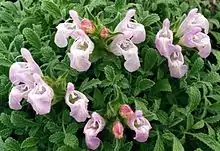Salvia caespitosa
Salvia caespitosa is a herbaceous perennial native to rocky limestone and volcanic slopes, at 4600–7900 ft elevation, in central and southern Anatolia. It has been grown in horticulture since the 1950s, typically in rock gardens, due to its dwarf, mat-growing habit. Caespitosa refers to its habit of "growing in dense clumps or tufts", with divided leaves and stems that grow in bunches, rather than being evenly spaced. The pale pinkish lilac flowers, about 1.6 in long, grow on very short inflorescences that are barely longer than the leaf.[1]
| Salvia caespitosa | |
|---|---|
 | |
| Scientific classification | |
| Kingdom: | Plantae |
| Clade: | Tracheophytes |
| Clade: | Angiosperms |
| Clade: | Eudicots |
| Clade: | Asterids |
| Order: | Lamiales |
| Family: | Lamiaceae |
| Genus: | Salvia |
| Species: | S. caespitosa |
| Binomial name | |
| Salvia caespitosa | |
Notes
- Clebsch, Betsy; Barner, Carol D. (2003). The New Book of Salvias. Timber Press. p. 55. ISBN 978-0-88192-560-9.
This article is issued from Wikipedia. The text is licensed under Creative Commons - Attribution - Sharealike. Additional terms may apply for the media files.